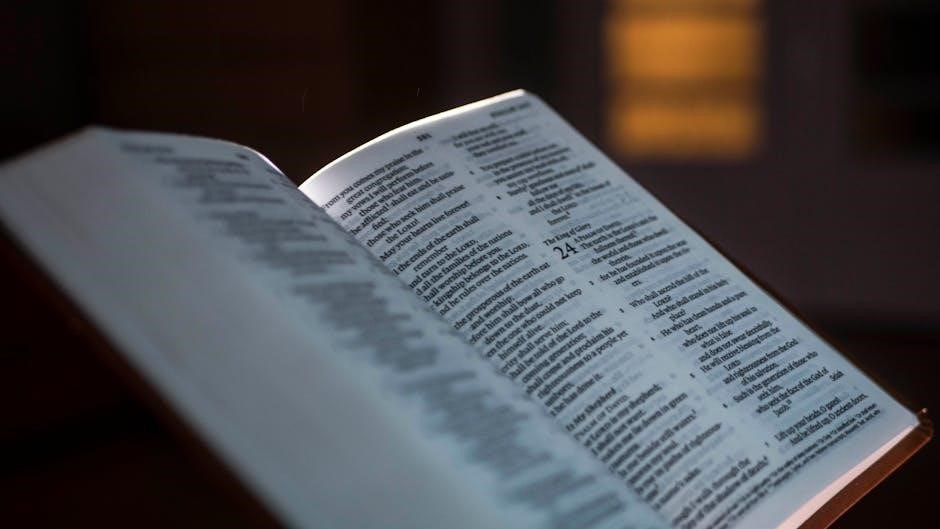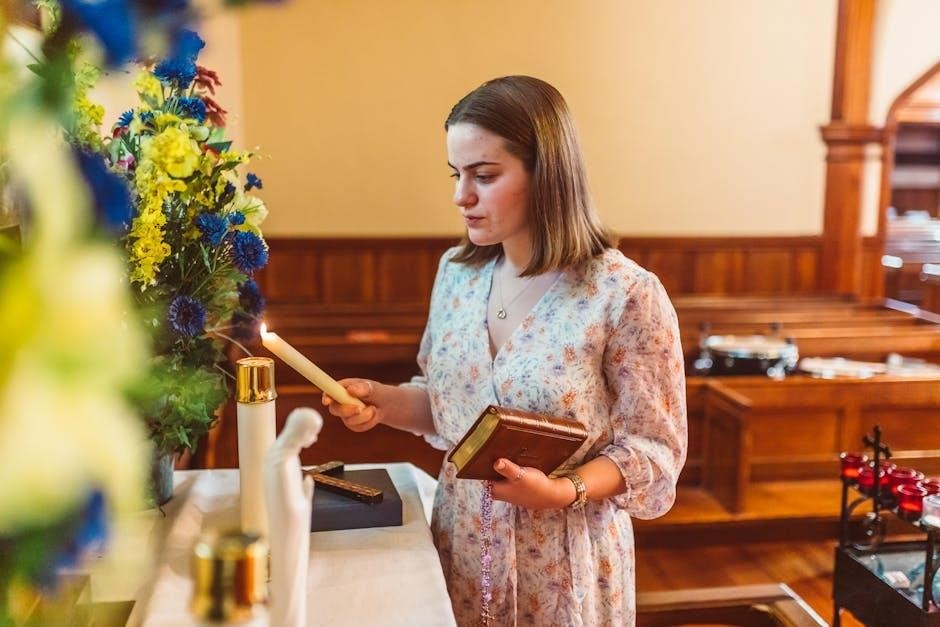The Book of Blessings is a liturgical resource of the Catholic Church, containing prayers and rituals for various blessings. Approved by the National Conference of Catholic Bishops, it is based on the Roman Ritual, revised following the Second Vatican Council. This comprehensive guide provides blessings for objects, people, and occasions, reflecting the Church’s tradition of invoking God’s grace in daily life. It serves as a valuable tool for both clergy and laity, enriching spiritual practices and fostering devotion.
1.1 Overview of the Book of Blessings
The Book of Blessings is a liturgical resource of the Catholic Church, containing prayers and rituals for various blessings; Approved by the National Conference of Catholic Bishops, it is based on the Roman Ritual, revised following the Second Vatican Council. This comprehensive guide provides blessings for objects, people, and occasions, reflecting the Church’s tradition of invoking God’s grace in daily life. It serves as a valuable tool for both clergy and laity, enriching spiritual practices and fostering devotion. The book is widely available in PDF format, making it accessible for digital use in liturgical celebrations and personal worship.
1.2 Historical Context and Development
The Book of Blessings traces its roots to the Roman Ritual, a traditional liturgical text of the Catholic Church. Following the Second Vatican Council, the Church undertook a significant revision of its liturgical practices, leading to the publication of the Latin edition, De Benedictionibus, in 1984. This revision aimed to align the blessings with the council’s emphasis on active participation and the renewal of sacramental life. The Book of Blessings was later adapted for use in various regions, including the United States, where it was approved by the National Conference of Catholic Bishops. Its development reflects the Church’s ongoing effort to provide meaningful liturgical resources that foster devotion and spiritual growth among the faithful.

Structure and Content of the Book of Blessings
The Book of Blessings is structured to provide a comprehensive collection of liturgical prayers and rituals. It includes blessings for various occasions, such as the dedication of churches, the consecration of altars, and the blessing of religious articles. The book is divided into sections, each addressing specific needs and circumstances, ensuring a wide range of applications. Its content reflects the Catholic Church’s rich tradition of invoking divine grace through sacramentals. The structure is designed to guide both clergy and laity in the proper use of blessings, making it a practical and deeply spiritual resource for the faith community.
2.1 Types of Blessings Included
The Book of Blessings encompasses a diverse array of blessings, each serving distinct purposes within Catholic liturgical life. It includes blessings for religious articles, such as rosaries, medals, and icons, which are sacred objects used in devotion. Additionally, there are blessings for people in various states of life, including the sick, children, and the elderly, offering comfort and spiritual support. Blessings for places, like homes and workplaces, are also provided to sanctify everyday environments. The book further contains rituals for special occasions, such as the dedication of churches and the blessing of animals, highlighting the Catholic belief in God’s presence in all aspects of life. These blessings are sacramentals, drawing believers closer to God and deepening their faith.
2.2 Blessings for Specific Occasions and Groups
The Book of Blessings provides rituals for specific occasions, such as the dedication of homes, blessings for animals, and ceremonies for the sick. It also includes blessings tailored for particular groups, including children, the elderly, and those in need of healing. These rituals emphasize the Catholic belief in God’s presence in all life circumstances. Blessings for homes aim to sanctify living spaces, while those for animals reflect stewardship over creation. Prayers for the sick and vulnerable offer comfort and hope, aligning with the Church’s mission to care for all. These blessings are sacramentals, drawing believers closer to God and strengthening their faith in everyday life and challenges.

The Role of Blessings in Catholic Tradition
Blessings are sacramentals that symbolize God’s grace, sanctifying life’s moments. They express worship, thanksgiving, and trust in divine providence, enriching Catholic devotion and daily life.
3.1 Sacramentals and Their Significance
Sacramentals, such as blessings, are sacred signs that convey spiritual grace and protection. They are integral to Catholic devotion, drawing believers closer to God. The Book of Blessings provides these rituals, enabling faith expression in various life circumstances. By invoking divine favor, sacramentals strengthen devotion and provide comfort, reflecting the Church’s belief in God’s active presence in the world.

3.2 Blessings as Acts of Worship and Thanksgiving
Blessings are profound acts of worship and thanksgiving, expressing devotion to God and acknowledging divine providence. They are moments of prayerful reflection, where individuals or communities give praise for God’s blessings and seek His continued grace. The Book of Blessings offers rituals that honor life’s milestones, from the consecration of homes to the blessing of the sick. These acts deepen faith, foster gratitude, and strengthen spiritual bonds. By invoking God’s favor, blessings become a testament to trust in His presence and care, enriching both personal and communal spiritual journeys.

Key Blessings and Prayers in the Book
The Book of Blessings includes prayers for consecrating religious items, blessing the sick, and praying for children and the elderly, reflecting God’s grace in life.
4.1 Blessings for Religious Articles
The Book of Blessings provides sacred prayers for consecrating religious articles, such as rosaries, medals, and icons. These blessings, often performed by clergy, honor the sacred nature of these items. They invoke divine protection and grace, ensuring the articles serve as powerful symbols of faith. The rituals emphasize the importance of sacramentals in Catholic tradition, offering a tangible connection to the divine. This section details the proper liturgical prayers and gestures for such blessings, ensuring their meaningful use in devotion and worship.
4.2 Blessings for Individuals: The Sick, Children, and the Elderly
The Book of Blessings includes specific prayers for the sick, children, and the elderly, offering comfort and divine grace. Blessings for the sick are rooted in faith, seeking healing and strength, while those for children emphasize protection and spiritual growth. Blessings for the elderly honor their wisdom and life experience, invoking continued grace in their later years. These rituals are deeply personal, providing solace and hope. They are typically performed by clergy but can also involve family and community participation. The prayers are rich in symbolism, reflecting the Church’s care for all stages of life and its commitment to spiritual well-being.

The Liturgical and Ritual Context
The Book of Blessings is deeply rooted in the Roman Ritual, reflecting Vatican II’s emphasis on liturgical renewal. It integrates sacred traditions with pastoral needs, providing structured prayers for various rituals and ceremonies, ensuring a balanced and meaningful worship experience.
5.1 The Roman Ritual and Vatican II Reforms
The Book of Blessings is an integral part of the Roman Ritual, revised following the Second Vatican Council. Vatican II emphasized liturgical renewal, encouraging active participation and clearer expression of the Church’s tradition. The reforms led to the creation of the Latin edition, De Benedictionibus, in 1984, which was later adapted into various languages. These changes aimed to make blessings more accessible and relevant to modern life while preserving their sacramental character. The revised ritual reflects a deeper connection to scriptural and patristic sources, ensuring that blessings are both devotionally rich and pastorally effective in the lives of the faithful.
5.2 The Use of the Book of Blessings in Liturgical Celebrations
The Book of Blessings is a vital resource in Catholic liturgical celebrations, offering a wide array of blessings for diverse occasions. It is frequently used during Mass, devotional services, and sacramental rites to invoke God’s grace and foster spiritual growth. Blessings from the book are incorporated into rituals such as the dedication of altars, the blessing of religious objects, and prayers for the sick or elderly. Clergy utilize these liturgical texts to lead communities in worship, ensuring that the blessings are performed with dignity and reverence. The book’s structure and content make it an essential tool for enriching liturgical life and deepening the faith of the congregation.

Blessings Reserved for Clergy
Certain blessings are reserved for clergy, reflecting the Church’s hierarchical structure. These include blessings reserved for bishops and priests, with some exclusive to the Pope, emphasizing their spiritual authority.
6.1 Hierarchical Structure: Blessings by Bishops and Priests
The Catholic Church’s hierarchical structure designates specific blessings to bishops and priests, reflecting their sacramental authority. Bishops, as successors of the apostles, have the privilege of performing solemn blessings, such as the consecration of churches and altars. Priests, acting in persona Christi, impart blessings for individuals, objects, and occasions, such as homes, religious articles, and the sick. This distinction emphasizes the ordained clergy’s role as mediators of God’s grace. The hierarchy ensures that blessings are administered in harmony with the Church’s liturgical traditions, preserving the sacred nature of these rites. This structure also underscores the importance of ordained ministry in the sacramental life of the faithful.
6.2 Special Blessings Reserved for the Pope
The Pope holds exclusive authority to perform certain blessings that underscore his unique role as the spiritual leader of the Catholic Church. These include the blessing of the pallium for archbishops, symbolizing their connection to the Holy See, and the apostolic blessing granted to the faithful, especially during significant events. The Golden Rose, a venerable papal blessing, is bestowed upon shrines and distinguished individuals as a mark of special devotion. Such blessings reflect the Pope’s supreme pastoral authority and his role in maintaining the unity of the global Church. These sacred rites are deeply rooted in tradition and reinforce the Pope’s central position in Catholic liturgical and spiritual life.

Cultural and Devotional Significance
The Book of Blessings holds profound cultural and devotional significance, fostering a deeper connection to Catholic faith and traditions. It enriches spiritual life through sacred rituals and prayers, emphasizing gratitude and reverence for God’s presence in all aspects of life. By providing structured blessings, it preserves Catholic heritage and encourages devotion, creating a bridge between the divine and everyday experiences.
7.1 The Book of Blessings in Catholic Devotional Life
The Book of Blessings plays a vital role in Catholic devotional life, offering a rich collection of prayers and rituals that deepen spiritual practices. It provides structured blessings for various aspects of life, such as homes, religious articles, and individuals, fostering a sense of reverence and gratitude. By incorporating these blessings into daily devotion, Catholics can invite God’s grace into their personal and communal lives, strengthening their faith and connection to the Church. The book serves as a meaningful resource for cultivating holiness and maintaining traditions, making it an essential companion for those seeking to enrich their spiritual journey.
7.2 The Role of Blessings in Family and Community Life
Blessings play a significant role in fostering unity and spirituality within families and communities. The Book of Blessings provides rituals for homes, children, and special events, strengthening family bonds and creating a sense of sacredness in daily life. These blessings, often performed by clergy or family members, serve as moments of prayer and thanksgiving, deepening faith and fostering a sense of togetherness. In community settings, shared blessings during gatherings or celebrations reinforce collective values and provide comfort. By integrating blessings into family and communal life, Catholics cultivate a vibrant spiritual culture that reflects their devotion and commitment to living out their faith in tangible ways.

Practical Uses of the Book of Blessings
The Book of Blessings serves as a practical guide for invoking God’s grace in homes, workplaces, and during special events, offering rituals for various life circumstances.
8.1 Blessings for Homes and Workplaces
The Book of Blessings includes rituals for consecrating homes and workplaces, invoking God’s protection and grace. These blessings, often performed by clergy, consecrate spaces to divine purposes, fostering peace and holiness. Specific prayers and symbols, like holy water and crosses, are used to sanctify environments. Blessings for homes emphasize family unity and safety, while workplace blessings seek prosperity and ethical conduct. These rituals encourage believers to integrate faith into daily life, creating sacred spaces that reflect God’s presence in all aspects of human endeavor. Such practices strengthen spiritual life and provide a sense of divine accompaniment in both personal and professional domains.
8.2 Blessings for Special Events and Occasions
The Book of Blessings provides rituals for marking significant life events and celebrations, such as weddings, anniversaries, graduations, and pilgrimages. These blessings are meant to invoke God’s grace and protection during pivotal moments. Specific prayers and ceremonies are included for occasions like the blessing of a new home, the dedication of a vehicle, or the consecration of religious articles. Additionally, blessings for seasonal celebrations, such as Advent and Easter, are featured, enriching the liturgical year. These rituals offer a way to sanctify everyday experiences, fostering a deeper connection to faith and community. They are often led by clergy but can also involve active participation from the faithful.

The Book of Blessings in the Digital Age
The Book of Blessings is now accessible in digital formats, including PDFs and online resources, making it easier for Catholics worldwide to access its rich liturgical content.
9.1 Availability of the Book of Blessings in PDF Format
The Book of Blessings is widely available in PDF format, facilitating easy access for Catholics worldwide. Official sources, such as Catholic Church websites and online repositories, offer downloadable versions. These PDFs include the complete text of the Book of Blessings, approved by the National Conference of Catholic Bishops. They are often free to download, enabling individuals to use the blessings for personal devotion or liturgical purposes. The PDF format ensures that the content is portable and searchable, making it a convenient resource for clergy and laity alike. This digital accessibility has modernized the traditional practice of blessings, ensuring their relevance in contemporary spiritual life.
9.2 Online Resources and Digital Access
The Book of Blessings is readily accessible through various online resources, making it convenient for Catholics to explore its contents digitally. Official Catholic websites, such as those of the United States Conference of Catholic Bishops, provide downloadable PDF versions of the text. Additionally, Catholic publishers and online repositories offer the book in digital formats, often free of charge or for a nominal fee. These resources ensure that the Book of Blessings remains accessible to a global audience, supporting spiritual practices and liturgical preparations. Digital access has also enabled easier sharing and study of the blessings, fostering a deeper connection to Catholic traditions and rituals in the modern era.
The Book of Blessings stands as a vital liturgical resource in Catholic tradition, offering a wide array of prayers and rituals to invoke God’s grace in various aspects of life. Its digital availability, including PDF formats, ensures accessibility for modern Catholics seeking to deepen their faith. By providing blessings for objects, individuals, and occasions, the book bridges the sacred and the everyday, fostering devotion and gratitude. It remains a cherished tool for clergy and laity alike, embodying the Church’s rich heritage of worship and thanksgiving. Through its timeless prayers, the Book of Blessings continues to inspire spiritual growth and connection to God’s divine mercy.
